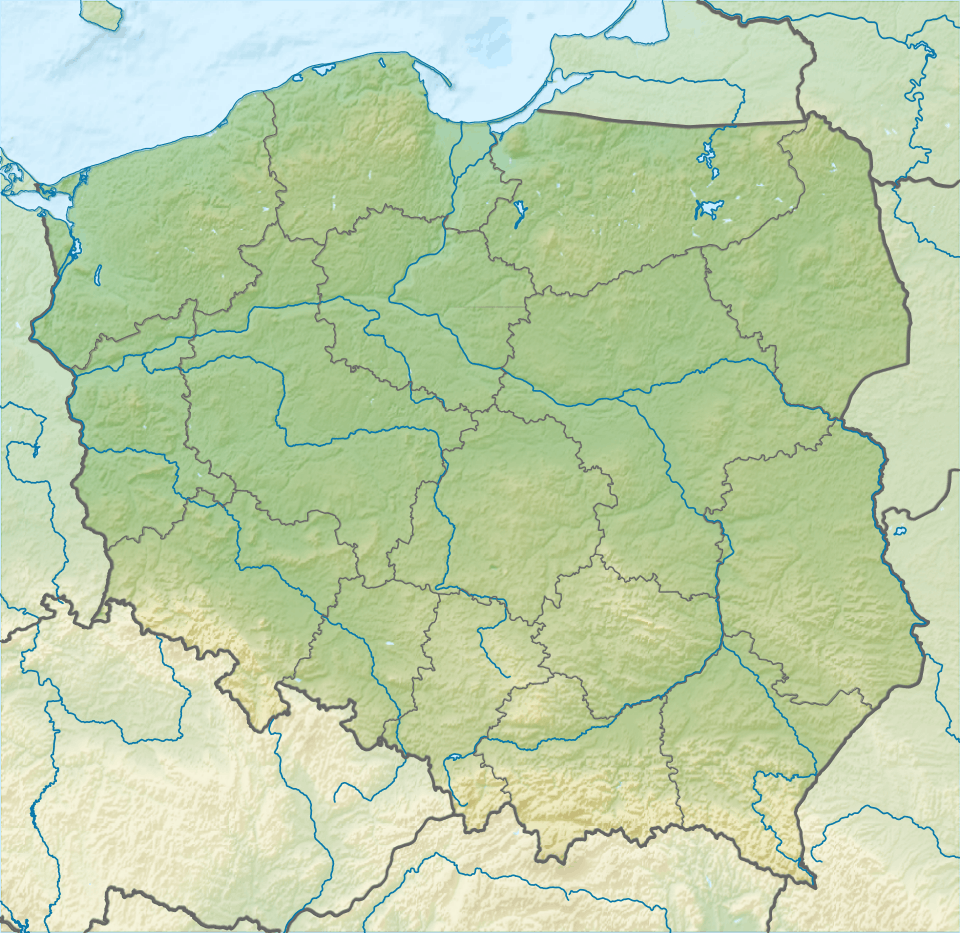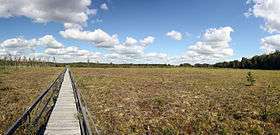Polesie National Park
Polesie National Park (Polish: Poleski Park Narodowy) is a National Park in Lublin Voivodeship, eastern Poland, in the Polish part of the historical region of Polesia. Created in 1990 over an area of 48.13 square kilometres, it covers a number of former peat-bog preserves: Durne Marsh (Durne Bagno), Moszne Lake (Jezioro Moszne), Długie Lake (Jezioro Długie), Orłowskie Peatland (Torfowisko Orłowskie). In 1994 its size was augmented by the addition of Bubnów Marsh (Bagno Bubnów), a swampy terrain adjacent to the park. Currently, the park occupies 97.62 km2 (37.69 sq mi), of which forests make up 47.8 km², and water and wastelands 20.9 km².
| Polesie National Park | |
|---|---|
| Poleski Park Narodowy | |
IUCN category II (national park) | |
Dominik Trail at Polesie National Park
 | |
 Location in Poland  | |
| Location | Lublin Voivodeship, Poland |
| Nearest city | Urszulin |
| Coordinates | 51°16′N 23°05′E |
| Area | 97.62 km² |
| Established | 1990 |
| Governing body | Ministry of the Environment |
| Website | www2 |
| Official name | Poleski National Park |
| Designated | 29 October 2002 |
| Reference no. | 1565[1] |
The idea of creating a National Park in the Polish part of Polesie first appeared in 1959. Over the following years a few preserves were organized here, and in 1982 the government announced the creation of Poleski Park Krajobrazowy (Polesie Landscape Park). Currently, even though Polesie’s infrastructure is quite well developed, it is rarely visited by tourists. In the village of Załucze Stare there is a cultural center with a museum.
The National Park and neighbouring areas form the West Polesie biosphere reserve, designated by UNESCO in 2002. The Shatsky National Natural Park is adjacent on the Ukrainian side of the border. The Park is also protected under the Ramsar convention as an important wetland site.
World War II history
After the invasion of Poland, Nazi Germany planned to set up a "Jewish reservation" in the Polesie National Park known for its swampy nature.[2][3] Adolf Eichmann was assigned the task of removing all Jews from Germany, Austria, and the Protectorate of Bohemia and Moravia to this reservation.[4] The first short-term plan to be implemented was to concentrate the Jews around Nisko.[5] Deportations began in October 1939.[6] The "Nisko Plan" initially intended to remove 80,000 Jews from the so-called Greater German Reich,[7] was scrapped in April 1940.[8][9] By that time 95,000 Jews chiefly from Poland were already deported to this area.[10] They were pressed to work in the RSHA camps of Generalplan Ost.[11] By mid-October however, the idea of a "Jewish reservation" was revived.[12][13] Resettlement actions connected to this plan continued until January 1941 under Globocnik,[14] and included both Jews and Poles.[15] Some 51 camps were created,[16] but further plans of deporting up to 600,000 additional Jews to the Lublin reservation failed because of logistical factors.[12] Notably, in less than two years the whole district would lend itself to the industrialized murder of hundreds of thousands of Jews during Operation Reinhard.[3]
Geography
The park lies on the Łęczna-Włodawa Lakeland (Pojezierze Łęczyńsko-Włodawskie). In the south it borders the Lublin Upland, in the north the region of Podlaskie, and in the west Masovia. Parts of its forests can be considered as tundra-like, which is unique in continental Europe and characteristic of Russian Siberia. The park’s terrain is flat, with numerous lakes and peat-bogs.
Ecology
Of the plant species, the greater part is made up of boreal plants, typical of other parts of northern Europe, but there is also some Atlantic flora, as it lies on the border of these important plant regions. The region which is particularly rich with flora is the Bagno Bubnów. Animal life is abundant, including 21 species of fish, 12 species of amphibians, 6 species of reptiles and up to 150 species of birds (including several endangered eagles). Out of 35 species of mammals, one can point out otters, elks, beavers and bats.
The ecosystems of swamps and peat-bogs, which dominate the park’s landscape, are considered very delicate and can easily be influenced by several outside factors. Some unfortunate changes were made by draining swamps, which took place mainly during World War II, when the area became the focus of the Nazi German "Lublin und Nisko Plan". However, the most important threat to the life of the park is its proximity to the Lublin Coal Basin, which is located less than 2 kilometers from the park’s protective zone.
The park includes an endangered Important Bird Area "Bubnow Marsh" of Poland. [17]
| Wikimedia Commons has media related to Polesie National Park. |
See also
- List of national parks of Poland
Notes
- "Poleski National Park". Ramsar Sites Information Service. Retrieved 25 April 2018.
- Cesarani 2016, p. 264.
- Yahil 1990, p. 160.
- Cesarani 2004, pp. 77–79.
- Gerlach 2016, p. 60.
- Niewyk & Nicosia 2000, p. 153.
- Cesarani 2004, pp. 259, 280, 288.
- Niewyk & Nicosia 2000, p. 154.
- Cesarani 2016, p. 260.
- Rozett & Spector 2013, p. 133.
- Edelheit 1994, p. 52, 241.
- Cesarani 2016, p. 262.
- Cesarani 2016, pp. 261–263.
- Cesarani 2004, p. 266.
- Longerich 2010, pp. 156-159.
- Poprzeczny, Joseph (2013). Odilo Globocnik, Hitler’s Man in the East. McFarland. p. 160. ISBN 0786481463.
- "Bubnow Marsh", a fact sheet of BirdLife International
References
- Official website
- Cesarani, David (2016). Final Solution: The Fate of the Jews 1933–1949. New York: St. Martin's Press. ISBN 978-1-250-00083-5.CS1 maint: ref=harv (link) - read online
- Edelheit, Abraham J. (1994). History of the Holocaust: A Handbook and Dictionary. Westview Press. ISBN 0813322405.CS1 maint: ref=harv (link)
- Gerlach, Christian (2016). The Extermination of the European Jews. Cambridge, UK: Cambridge University Press. ISBN 0-521-70689-0.CS1 maint: ref=harv (link)
- Niewyk, Donald L.; Nicosia, Francis R. (2000). The Columbia Guide to the Holocaust. New York: Columbia University Press. ISBN 0-231-11200-9.CS1 maint: ref=harv (link)
- Longerich, Peter (2010). Holocaust: The Nazi Persecution and Murder of the Jews. Oxford, UK: Oxford University Press. ISBN 978-0-19-280436-5.CS1 maint: ref=harv (link)
- Rozett, Robert; Spector, Shmuel (2013). Encyclopedia of the Holocaust. Routledge. pp. 133, 161, 274. ISBN 1135969574.
- Yahil, Leni (1990). The Holocaust: The Fate of European Jewry, 1932–1945. New York: Oxford University Press. ISBN 978-0-19-504523-9.
San Vistula Bug.
CS1 maint: ref=harv (link) - Polish national parks (in English)
- The Board of Polish National Parks